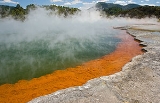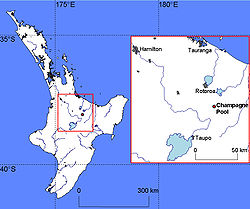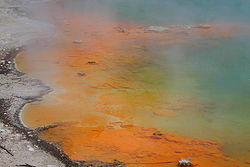
Champagne Pool
Encyclopedia
Champagne Pool is a prominent geothermal feature within the Wai-O-Tapu
geothermal area in the Bay of Plenty Region of the North Island of New Zealand
. The terrestrial hot spring
is located about 30 km (18.6 mi) southeast of Rotorua
and about 50 km (31.1 mi) northeast of Taupo
. The name Champagne Pool is derived from the abundant efflux of carbon dioxide
(CO2), similar to a glass of bubbling champagne. The hot spring was formed 900 years ago by a hydrothermal eruption, which makes it in geological terms a relatively young system. Its crater is around 65 m (213.3 ft) in diameter with a maximum depth of approximately 62 m (203.4 ft) and is filled with an estimated volume of 50000 cubic metre of geothermal fluid.
 The deep geothermal water below Champagne Pool is of the order of 260 °C (500 °F) but water temperature within the pool is maintained at 73 °C (163.4 °F) to 75 °C (167 °F) by losing heat to the atmosphere. The pH
The deep geothermal water below Champagne Pool is of the order of 260 °C (500 °F) but water temperature within the pool is maintained at 73 °C (163.4 °F) to 75 °C (167 °F) by losing heat to the atmosphere. The pH
of 5.5 is relatively constant due to buffering by the flux of CO2. Gases are mainly CO2, but to less extent nitrogen
(N2), methane
(CH4), hydrogen
(H2), hydrogen sulphide
(H2S) and traces of oxygen
(O2). The siliceous geothermal fluid is oversaturated with metalloid
compounds such as orpiment
(As2S3) and stibnite
(Sb2S3), which precipitate and form orange subaqueous deposits. The colourful deposits are in sharp contrast to the grey-white silica sinter surrounding Champagne Pool.
 Although Champagne Pool is geochemically well characterised, few studies have addressed its role as a potential habitat
Although Champagne Pool is geochemically well characterised, few studies have addressed its role as a potential habitat
for microbial life forms. H2 and either CO2 or O2 would be available as metabolic energy sources for autotrophic growth of methanogenic or hydrogen-oxidising microorganisms. Culture-independent methods provided evidence for filamentous, coccoid and rod-shaped cell morphologies in the hot spring. Two novel bacteria
and a novel archaeon have been successfully isolated from Champagne Pool. Bacterial isolate CP.B2 named Venenivibrio stagnispumantis
tolerates relatively high concentrations of arsenic
and antimony
compounds and represents a novel genus
and species
within the order
Aquificales.
Wai-O-Tapu
Wai-O-Tapu is an active geothermal area at the southern end of the Okataina Volcanic Centre, just north of the Reporoa caldera, in New Zealand's Taupo Volcanic Zone. The area has many hot springs noted for their colourful appearance, in addition to the Lady Knox Geyser...
geothermal area in the Bay of Plenty Region of the North Island of New Zealand
New Zealand
New Zealand is an island country in the south-western Pacific Ocean comprising two main landmasses and numerous smaller islands. The country is situated some east of Australia across the Tasman Sea, and roughly south of the Pacific island nations of New Caledonia, Fiji, and Tonga...
. The terrestrial hot spring
Hot spring
A hot spring is a spring that is produced by the emergence of geothermally heated groundwater from the Earth's crust. There are geothermal hot springs in many locations all over the crust of the earth.-Definitions:...
is located about 30 km (18.6 mi) southeast of Rotorua
Rotorua
Rotorua is a city on the southern shores of the lake of the same name, in the Bay of Plenty region of the North Island of New Zealand. The city is the seat of the Rotorua District, a territorial authority encompassing the city and several other nearby towns...
and about 50 km (31.1 mi) northeast of Taupo
Taupo
Taupo is a town on the shore of Lake Taupo in the centre of the North Island of New Zealand. It is the seat of the Taupo District Council and lies in the southern Waikato Region....
. The name Champagne Pool is derived from the abundant efflux of carbon dioxide
Carbon dioxide
Carbon dioxide is a naturally occurring chemical compound composed of two oxygen atoms covalently bonded to a single carbon atom...
(CO2), similar to a glass of bubbling champagne. The hot spring was formed 900 years ago by a hydrothermal eruption, which makes it in geological terms a relatively young system. Its crater is around 65 m (213.3 ft) in diameter with a maximum depth of approximately 62 m (203.4 ft) and is filled with an estimated volume of 50000 cubic metre of geothermal fluid.
Hydrochemistry

PH
In chemistry, pH is a measure of the acidity or basicity of an aqueous solution. Pure water is said to be neutral, with a pH close to 7.0 at . Solutions with a pH less than 7 are said to be acidic and solutions with a pH greater than 7 are basic or alkaline...
of 5.5 is relatively constant due to buffering by the flux of CO2. Gases are mainly CO2, but to less extent nitrogen
Nitrogen
Nitrogen is a chemical element that has the symbol N, atomic number of 7 and atomic mass 14.00674 u. Elemental nitrogen is a colorless, odorless, tasteless, and mostly inert diatomic gas at standard conditions, constituting 78.08% by volume of Earth's atmosphere...
(N2), methane
Methane
Methane is a chemical compound with the chemical formula . It is the simplest alkane, the principal component of natural gas, and probably the most abundant organic compound on earth. The relative abundance of methane makes it an attractive fuel...
(CH4), hydrogen
Hydrogen
Hydrogen is the chemical element with atomic number 1. It is represented by the symbol H. With an average atomic weight of , hydrogen is the lightest and most abundant chemical element, constituting roughly 75% of the Universe's chemical elemental mass. Stars in the main sequence are mainly...
(H2), hydrogen sulphide
Hydrogen sulfide
Hydrogen sulfide is the chemical compound with the formula . It is a colorless, very poisonous, flammable gas with the characteristic foul odor of expired eggs perceptible at concentrations as low as 0.00047 parts per million...
(H2S) and traces of oxygen
Oxygen
Oxygen is the element with atomic number 8 and represented by the symbol O. Its name derives from the Greek roots ὀξύς and -γενής , because at the time of naming, it was mistakenly thought that all acids required oxygen in their composition...
(O2). The siliceous geothermal fluid is oversaturated with metalloid
Metalloid
Metalloid is a term used in chemistry when classifying the chemical elements. On the basis of their general physical and chemical properties, each element can usually be classified as a metal or a nonmetal. However, some elements with intermediate or mixed properties can be harder to characterize...
compounds such as orpiment
Orpiment
Orpiment, As2S3, is a common monoclinic arsenic sulfide mineral. It has a Mohs hardness of 1.5 to 2 and a specific gravity of 3.46. It melts at 300 °C to 325 °C...
(As2S3) and stibnite
Stibnite
Stibnite, sometimes called antimonite, is a sulfide mineral with the formula Sb2S3. This soft grey material crystallizes in an orthorhombic space group. It is the most important source for the metalloid antimony...
(Sb2S3), which precipitate and form orange subaqueous deposits. The colourful deposits are in sharp contrast to the grey-white silica sinter surrounding Champagne Pool.
Biology

Habitat
* Habitat , a place where a species lives and grows*Human habitat, a place where humans live, work or play** Space habitat, a space station intended as a permanent settlement...
for microbial life forms. H2 and either CO2 or O2 would be available as metabolic energy sources for autotrophic growth of methanogenic or hydrogen-oxidising microorganisms. Culture-independent methods provided evidence for filamentous, coccoid and rod-shaped cell morphologies in the hot spring. Two novel bacteria
Bacteria
Bacteria are a large domain of prokaryotic microorganisms. Typically a few micrometres in length, bacteria have a wide range of shapes, ranging from spheres to rods and spirals...
and a novel archaeon have been successfully isolated from Champagne Pool. Bacterial isolate CP.B2 named Venenivibrio stagnispumantis
Venenivibrio stagnispumantis
Venenivibrio stagnispumantis strain CP.B2 is the first microorganisms isolated from the terrestrial hot spring Champagne Pool in Waiotapu, New Zealand.-Morphology:...
tolerates relatively high concentrations of arsenic
Arsenic
Arsenic is a chemical element with the symbol As, atomic number 33 and relative atomic mass 74.92. Arsenic occurs in many minerals, usually in conjunction with sulfur and metals, and also as a pure elemental crystal. It was first documented by Albertus Magnus in 1250.Arsenic is a metalloid...
and antimony
Antimony
Antimony is a toxic chemical element with the symbol Sb and an atomic number of 51. A lustrous grey metalloid, it is found in nature mainly as the sulfide mineral stibnite...
compounds and represents a novel genus
Genus
In biology, a genus is a low-level taxonomic rank used in the biological classification of living and fossil organisms, which is an example of definition by genus and differentia...
and species
Species
In biology, a species is one of the basic units of biological classification and a taxonomic rank. A species is often defined as a group of organisms capable of interbreeding and producing fertile offspring. While in many cases this definition is adequate, more precise or differing measures are...
within the order
Order (biology)
In scientific classification used in biology, the order is# a taxonomic rank used in the classification of organisms. Other well-known ranks are life, domain, kingdom, phylum, class, family, genus, and species, with order fitting in between class and family...
Aquificales.

